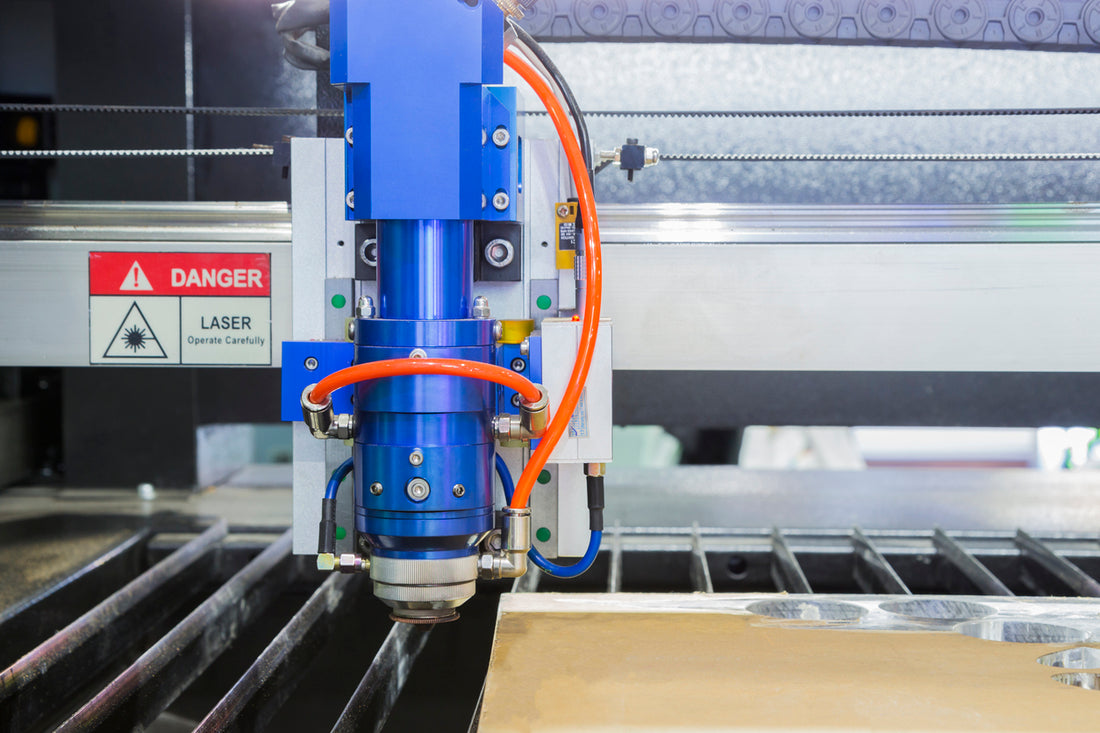Bright spots in the solid state: Your comprehensive guide to the solid state laser
Have you ever wondered how exactly a laser works? Specifically, what is a solid-state laser ? Then you are exactly right here. In this guide we want to shed light on the darkness and examine this fascinating topic together.
Solid-state lasers are a widely used type of laser and play an important role in a variety of areas, from industrial manufacturing to medicine. But before we dive into the details, let's first look at the laser itself and its basic functionality.
The Light of Innovation: Basics of Lasers
The shiny centerpiece: What is a laser?
A laser, whose name comes from “Light Amplification by Stimulated Emission of Radiation,” is not just a light source. It is an extremely precise tool that generates light and converts it into an intense, narrowly focused and monochromatic beam. "Monochromatic" here means that the laser beam consists of light of a single wavelength, which distinguishes it from conventional light sources that emit light of many different wavelengths. In our blog article “What is a laser?” Let's explain the process in more detail.
Light in categories: Classification of lasers
There are many different types of lasers that can be classified based on their active medium. The active medium is the material used to generate the laser light. In this medium the stimulated emission takes place and depending on the type of medium, different wavelengths and powers of the light generated can be achieved.
We mainly distinguish between four types of lasers: solid-state lasers, gas lasers, diode lasers and fiber lasers.
Lasers in different physical states: Differences between laser types
- Solid-state laser : A solid-state laser is a type of laser in which a solid serves as the active medium. This usually consists of a crystal or glass that is provided with a suitable dopant. A prominent example is the Nd:YAG laser , which uses a neodymium-doped yttrium aluminum garnet crystal as the active medium
- Gas lasers : Gas lasers use a gas or gas mixture as the active medium. Perhaps the most well-known gas laser is the helium-neon laser, which uses a mixture of helium and neon and emits red light. Gas lasers can cover a wide range of wavelengths, depending on the gases used
- Diode lasers : Diode lasers use semiconductor materials as the active medium. They are small, energy efficient and have a long lifespan. Because they directly convert electrical current into light, they are very common in many everyday applications, such as telecommunications and laser printers
- Fiber lasers : Fiber lasers use an optical fiber as the active medium. The light is guided along the fiber and amplified by built-in mirrors. They offer high output powers and excellent beam quality, making them ideal for applications such as precision welding, cutting and laser marking
Amid the light: Structure and functionality of a solid-state laser
The most important components: A look at the inner workings
A solid-state laser consists of several main components, including the active medium, the resonator and the pumping system.
- Active medium : The heart of every laser is the active medium. In the case of a solid-state laser, this medium is a solid, usually a crystal such as yttrium aluminum garnet (YAG), which is mixed with a dopant such as neodymium. The atoms of this dopant are what make the laser process possible
- Resonator : The resonator is a crucial element in a laser . It consists of two mirrors arranged opposite each other. One of these mirrors allows a small part of the light to pass through, this is the output of the laser. The purpose of the resonator is to reflect the light back and forth in the active medium, thereby amplifying the stimulated emission
- Pumping system : The pumping system is responsible for bringing the atoms in the active medium into an excited state. As a rule, light of a specific wavelength is used, which is directed onto the active medium
Radiant Energy: The Pumping Mechanism and Energy Transfer
The operation of a solid-state laser begins with the pumping mechanism. The pump system delivers energy, mostly in the form of light, to the active medium. When this light hits the atoms in the active medium, they absorb the energy and enter an excited state. However, this state is unstable, and the atoms strive to return to their original, lower energy state. When they do this, they release their excess energy in the form of a photon, a particle of light. This process is known as spontaneous emission in solid-state lasers.
Amplification of light: emission and resonance
The photons produced travel through the active medium and strike other excited atoms, creating more photons that in turn strike other atoms, and so on. In this way, a cascade of photons is created - a chain reaction of light production.
However, these photons would easily radiate in all directions. This is where the resonator comes into play. The resonator's mirrors reflect the light back and forth through the active medium, with the photons striking more and more excited atoms and continuing the chain reaction. This process of repeated reflection and amplification results in an intense and directed beam of light - the laser beam.
The exit mirror at the end of the resonator allows a small part of the light to pass through. This is the laser beam produced, which is now ready for a wide variety of applications, be it industrial processes, medical treatments or scientific research.
Diversity in Solidity: Types of Solid State Lasers
There are different types of solid-state lasers, each with their own specific properties and applications:
- Nd:YAG Laser (Neodymium-Doped Yttrium Aluminum Garnet Laser): Nd:YAG lasers are widely used in numerous applications, including industry, due to their high beam quality and ability to operate at a wide range of temperatures for welding and drilling, in medicine for laser surgery and in research
- Er:YAG lasers (Erbium-doped yttrium aluminum garnet laser): Er:YAG lasers emit light at a wavelength that is particularly well absorbed by water and biological tissue, making them ideal for applications in dermatology and dentistry where they are used to cut and remove tissue
- Ti:Sapphire Laser (Titanium-Doped Sapphire Laser): Ti:Sapphire lasers are known for their extremely wide tunable emission bandwidth, making them one of the most versatile types of lasers, particularly popular in research and applications requiring precise control over the Require wavelength of emitted light
- Alexandrite laser (chromium-doped beryllium aluminum silicate laser): Alexandrite lasers are known for their high output power and wide tuning range, making them particularly useful for applications in hair removal, treatment of vascular lesions, and in certain industrial applications
- Other solid-state laser types and their specific properties: Beyond these common types, there are a wealth of other solid-state lasers, such as the ruby laser , which has gone down in history as the first functional laser, or the thulium laser , which is known for its specific emission properties used in medical technology and fiber communication
Focused brilliance: Applications of solid-state lasers
Like Molten Light: Materials Processing
One of the most important areas of application for solid-state lasers is material processing . They are used for cutting, welding and marking a variety of materials. The high energy and precision of the laser beam allows even hard or delicate materials to be processed with great precision. Whether in the automotive industry, where laser cutting and welding play a central role, or in microelectronics, where the finest structures are created using laser markers - solid-state lasers have become an integral part of modern material processing.
Precision Instruments of Healing: Medical Applications
Solid-state lasers have brought about revolutionary changes in medicine. They are used in eye surgery to correct vision problems or to treat cataracts. Their precision makes it possible to remove tissue in a targeted manner while at the same time protecting surrounding tissue. They have also become indispensable in dermatology: from the treatment of skin diseases to the removal of tattoos - they enable safe, effective and minimally invasive treatment.
Light in Science: Research
The world of science and research would be unimaginable without solid-state lasers . They are essential tools in spectroscopy to study the composition and properties of materials. They help us explore the secrets of condensed matter and develop new materials with incredible properties. They enable precise manipulation and control of atoms and molecules in quantum physics and quantum information.
Connecting Rays: Communication and Data Transmission
In our digitally connected world, solid-state lasers play a crucial role. They are a key element in fiber optic reinforcement used for high-speed data transmissions . The laser beam allows information to be transmitted over long distances with minimal signal loss, contributing to global networking and communication.
Visibility and Security: Military and Defense Technology
Solid-state lasers also have a wide range of applications in defense technology and the military. They are used for target illumination to increase the accuracy of weapon systems. They serve as rangefinders to provide accurate data for navigation and target acquisition. And they are even the subject of research for the development of laser weapon systems.
Light and shadow: advantages and disadvantages of solid-state lasers
In the fascinating world of solid-state lasers, numerous advantages illuminate the field. The high beam quality and power density enable precise applications, while their long service life and compact design provide a robust and long-lasting solution. However, there is also a dark side. Despite their performance, they are associated with high costs and their output power can often only be scaled to a limited extent. Additionally, their sensitivity to environmental influences is a challenge that requires careful handling and maintenance.
In radiance: care and maintenance of solid-state lasers
Maintaining the brilliant shine of a solid-state laser requires conscientious care and maintenance. The first rule is to handle the laser system carefully. Careful handling protects the sensitive components and guarantees a long service life. It is also important to only use the laser within its specified operating parameters to avoid overloads and associated damage.
Maintenance of a solid-state laser system includes regular checks and cleaning. The optical components, such as mirrors and lenses, should be checked for dirt or damage. If necessary, they should be cleaned carefully using suitable cleaning products and techniques. A well-maintained solid-state laser delivers consistently high performance and enables precise and reliable applications. This means your laser always shines in the best light.
Bright but safe: Safety aspects when handling solid-state lasers

The glowing presence of a solid-state laser poses potential dangers, including skin and eye damage from intense radiation. Safe handling therefore requires following applicable guidelines and regulations that cover the correct handling, installation and operation of the laser system. Technical protective measures are to be preferred. Only if these are not possible can protection be ensured through personal and organizational protective measures. Personal protective equipment, especially laser safety glasses, are essential and must correspond to the specific wavelength of the laser. Depending on the work environment, additional protective measures such as heat-resistant clothing or shields may be necessary. Essentially, respectful handling of the radiation power of the solid-state laser is the key to safety. So you can be amazed by its luminous brilliance without endangering the health of yourself or others.
The future in the spotlight: future developments and trends
Solid-state lasers not only shine brightly today, but also promise a bright future. Current research focuses on new materials and technologies to further improve the efficiency and performance of lasers. Emerging areas such as quantum communications and high-speed machining are benefiting from advances in laser development. New applications, such as in environmental technology or medicine, are also being opened up through the increasing versatility and performance of solid-state lasers. In the constant pursuit of improvement and innovation, solid-state lasers keep our world shining brightly. Their exciting development will certainly give us many more shining moments.
Lights out, curtains closed: conclusion
After this journey through the world of solid-state lasers, it can be said that they play a key role in many areas of our lives. Despite some challenges, they offer countless opportunities and have the potential to brighten our future.
So, don't be surprised the next time you hear about lasers, you think of solid-state lasers - they really are all around us, even if we can't always see them!
Image sources
Cover photo: © iStock.com/ warut1



